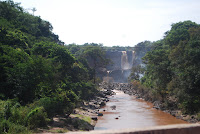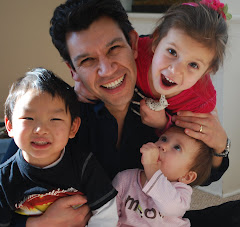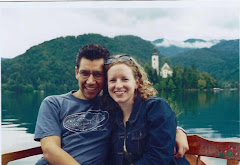
For breakfast we had some warm homemade bread, and our "usual" macchiato. We are living proof that non-coffee drinkers will be converted upon landing in Ethiopia. Remember the 1980 movie Airplane: "Jim never drinks a second cup of coffee at home." Tonio and I keep repeating that quote to each other as we ordered yet another macchiato. The coffee is SO good, and does not taste like coffee at home... it's like how Tonio only like Guiness in Ireland- we're not drink snobs, it just tastes better! While Yoseph went to buy our boat tickets in town, we were able to enjoy a little piece of paradise. Why was simple bread and coffee, eaten on a tiny metal table such an amazing breakfast? The awe-inspiring views overlooking the reddish Lake Abaya on the left and Lake Chamo on the right. The green, mountainous isthmus between the two lakes in Nechisar National Park has been called "Bridge of God" to reflect its beauty and serenity. In the picture below left, you can just barely glimpse the 2 lakes on either side of the "Bridge of God."


On our way to the boat launch, we were really happy to have a 4x4, driving over rocks with tree branches scratching the metal from front to back. We passed many baboons (who have been trained by tourists to come and beg for food), and some lesser kudus (type of deer). We were told that the park also has zebras, swans, gazelles, and even lions and leopards- although our plans today were to visit the crocodiles and hippos.
Our boat was cleverly painted in a zebra camouflage so the crocodiles wouldn't see us:

The breeze and spray of water on my face as we bounced over the small waves reminded me so much of weekends in Minnesota when I was a kid- fishing with my parents and siblings on the lakes. The only thing missing was a bucket of worms and the water-skis..

The overcast day was perfect for fishing, but also for enjoying the wildlife- no sunburn yet no rain!
Here's a crocodile swimming near our boat- I joked with our boat driver "Will they eat us?" He turned around from his perch in the bow and answered seriously, "They don't eat tourists. They eat the fishermen-" and he pointed to some fishermen who were wading in the shallow waters throwing out nets. He told us that his godfather was eaten by a crocodile when he was little! We couldn't tell if this was just a story for the tourists, but we didn't test it.
The hippos were schmoozing around in the sand right next to the pelicans and crocs:

Click on the pictures to see them bigger-


Apparently crocs like to hand out with their mouths open. On an episode of Wonder Pets, we were told they do this waiting for a bird to come by and clean its teeth. Our guide told us that this is incorrect, and says these Nile Crocodiles would eat said bird.. we'll have to email Bindi Irwin to find out why:).


The crocodile (at least 15ft long) above slithered into the water when it heard us... Crocodiles in the wild are waaaaaaaaaaaaay bigger than at the zoo! They call this little island where the crocs hang out the "Crocodile Market," and when reading this from home I thought it was a literal market..? I imagined people going there to buy crocodile skins for purses, and was a little outraged that it was a stop on our itinerary. Yoseph found this hilarious when I told him what I thought.


So many pelicans, marabous, herons and other water fowl..

Some crocs taking a nap:




Hippos, who rarely leave the water..

One of my favorite pictures from the trip is this one of a relaxed, well-rested, worry-free couple:

After the relaxing boat ride, we headed to the Arba Minch Hotel for more amazing food. One of my favorite drinks in Ethiopia is freshly squeezed juice (no added water:). They can make you a combo drink of several difference juices together, and the best is pineapple, avocado, mango. In Mexico and the US it is rare to consider avocado as sweet- we amost always make it salty (guacamole, salsas, en sopa). But in Morrocco, Brazi, and evidently in Ethiopia as well, they mix it with sweeter juices. So unexpectedly good!!! Here they were out of pineapple, so I just had avocado and mango- see how the fruit pulp is thick enough to maintain its separate identity??

Today was Friday, which meant we throw out the menu and order what is available: fasting (vegetarian) food. I love fasting!!!

The lush Arba Minch Hotel.

Ethiopia is split in 2 by a series of faults- where two plates come together to form the Earth's surface. It is a crack that runs north to south for something like 4000 miles, from Syria in the north, down through Ethiopia and then it forks off. The plates are slowly separating from each other, and eventually may cut Africa into two piece. In the meantime, there are tremors and volcanic activity in the area, and after millions of years in the making, numerous lakes have formed in the valleys of this zone. According to wikipedia, the African Rift Zone has some of the oldest, largest, and deepest lakes in the world. In the Ethiopian Rift Valley, Lake Abaya and Lake Chamo are the first and second largest (Lake Chamo is the site of our boat tour). Arba Minch, situated almost between these 2 lakes, means "40 springs." Their natural hot springs are heated by underground lava activity, and people come to visit the springs for recreation or for healing. As we left Arba Minch to drive the 270 km back to Awassa, we passed many streams and rivers where people were able to bathe and wash their clothes:




Some crocs taking a nap:




Hippos, who rarely leave the water..

One of my favorite pictures from the trip is this one of a relaxed, well-rested, worry-free couple:

After the relaxing boat ride, we headed to the Arba Minch Hotel for more amazing food. One of my favorite drinks in Ethiopia is freshly squeezed juice (no added water:). They can make you a combo drink of several difference juices together, and the best is pineapple, avocado, mango. In Mexico and the US it is rare to consider avocado as sweet- we amost always make it salty (guacamole, salsas, en sopa). But in Morrocco, Brazi, and evidently in Ethiopia as well, they mix it with sweeter juices. So unexpectedly good!!! Here they were out of pineapple, so I just had avocado and mango- see how the fruit pulp is thick enough to maintain its separate identity??

Today was Friday, which meant we throw out the menu and order what is available: fasting (vegetarian) food. I love fasting!!!

The lush Arba Minch Hotel.

Ethiopia is split in 2 by a series of faults- where two plates come together to form the Earth's surface. It is a crack that runs north to south for something like 4000 miles, from Syria in the north, down through Ethiopia and then it forks off. The plates are slowly separating from each other, and eventually may cut Africa into two piece. In the meantime, there are tremors and volcanic activity in the area, and after millions of years in the making, numerous lakes have formed in the valleys of this zone. According to wikipedia, the African Rift Zone has some of the oldest, largest, and deepest lakes in the world. In the Ethiopian Rift Valley, Lake Abaya and Lake Chamo are the first and second largest (Lake Chamo is the site of our boat tour). Arba Minch, situated almost between these 2 lakes, means "40 springs." Their natural hot springs are heated by underground lava activity, and people come to visit the springs for recreation or for healing. As we left Arba Minch to drive the 270 km back to Awassa, we passed many streams and rivers where people were able to bathe and wash their clothes:


Yoseph stopped to by charcoal (for cooking) for the woman who rents him his room in Addis. He said the quality here is very good and that she will appreciate it very much. We passed through the Gabbo tribe (similar to Dorze people, near Arba Minch) and then little villages of the Woleyta tribe.


Near Soddo, we saw a lot of construction of apartment buildings, lots of timber, and a lot of wooden furniture, made by carpenters outside. 







I love this picture of a little boy in a field (click to make it bigger). The next one is of a corn harvest. The bottom two are typical houses in this region:








The roads were now paved, and in great condition for cars, cattle, donkeys, goats, or just walking.











Driving through seemingly the middle of nowhere, it takes you aback when all of a sudden there is a cell phone tower and electricity poles. Rapid growth and indsutrialization: this is a picture of an emerging market.


The vegetation began to change as we drove north. What looks like agave or huge aloe vera plants were used to mark the borders of people's land. They also used tall and skinny cacti as fences (so similar to Mexico!).

Donkey taxis.. to haul people or goods.




We passed by Shashemene, a town north of Awassa (we went around Awassa on a different highway and came in from the north). When Ras Tafari (ras= duke, Tafari= Haile Selassie's given first name) was crowned emperor in 1930, people around the world hailed him as "divine," and as the messiah of African Redemption. Marcus Garvey proclaimed that it was a biblical prophesy coming true that "Kings will come from Africa," and many of his followers began to worship Haile Selassie. At first Selassie was embarrassed, but it didn't last too long. In 1963, Selassie gave free land to many Rastas, who came to live here in Shashemene and establish a community. We didn't see any on our quick drive through.









Nearing Awassa

Driving to Awassa, coming from the north. We passed through Sidama people, Derasa, Hadiya, Kambatu, and Alaba.






This is where the trip took a sharp diversion from our original plan. We had planned to spend part of the day in Awassa tomorrow, and then drive back up to Addis-- and then the next day drive from Addis back down to Awassa. It seemed like too much driving, and a waste of time; we'd much rather spend time in the town that Ricky is from! So we asked Yoseph to phone Ato Teklu (who is WACAP's on the ground lawyer, and man in charge of everything) to find out where we would be staying in Awassa. It was very confusing because Ato Teklu didn't know who we were and didn't understand what we were asking. Finally he called our guide back and told him the name of the hotel where other WACAP adoptive parents have stayed in the past. We then called WACAP in the US, and told her we would just meet her in Awassa, and to please, please bring our suitcase and donations from the TDS hotel in Addis, to Awassa when they come. We then found the "Oasis International Hotel," walked inside and found some other Americans that were from WACAP! It was an incredible feeling that made the world feel so small:). One of the last groups to only make one trip, they are going back to Addis tomorrow morning for their Embassy date and to be with their kiddos. We bid Yoseph good-bye until morning, and had a great dinner with the other families.



















3 comments:
I am LOVING your account of you time in Ethiopia and I can only imagine how much Ricky will appreciate it one day. Been thinking of you a lot and I know that I owe you a phone call but I haven't wanted to bother you when things are so so busy getting ready for your return trip. Ricky is adorable...can't wait to see more of him!
I'm so glad you're giving such a thorough update of the trip on your blog. We love all the tidbits about the culture, the food, the history...and the photos, of course!
Megan
Have you ever seen the show "River Monsters" on Animal Planet? It's a crazy show, but my hubs and I watch it religiously. Anyway, they did a show from Ethiopia, from the "Crocodile Market" that you mentioned! You need to watch the show - pretty amazing, especially since you have been there now!
Post a Comment